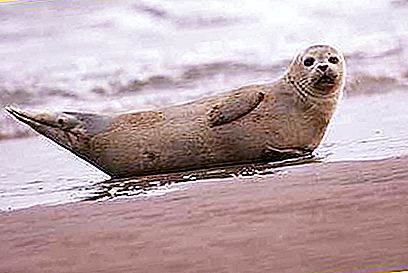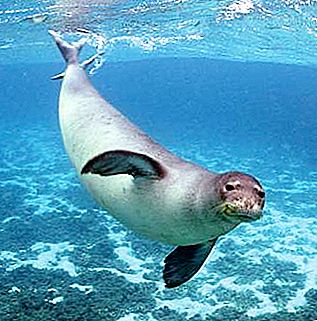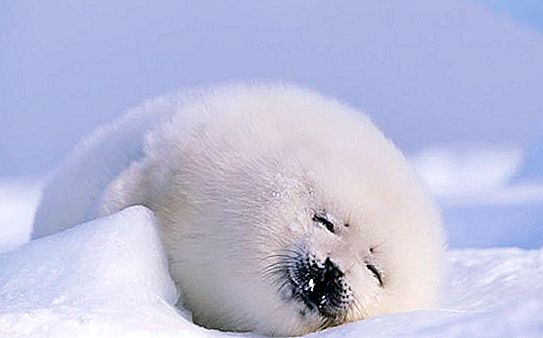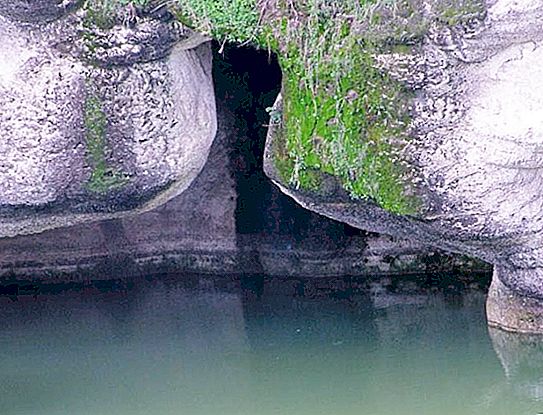Seals - the common name for marine mammals, uniting representatives of two families: real and eared seals. Clumsy enough on land, they swim perfectly underwater. Their traditional habitat is the coastal zones of southern and northern latitudes. The species of seals that exist in nature are very different, but at the same time, there are many common features in their appearance, habits and lifestyle.
Origin of seals
It is known that the ancestors of pinnipeds once walked freely on the ground. Later, perhaps due to the deterioration of climatic conditions, they were forced to sink into the water. In this case, most likely, real and eared seals came from different animals.
Scientists believe that the ancestors of the present, or ordinary, seal were creatures similar to the otters that fifteen million years ago met in the North Atlantic. The eared seal is more ancient - its ancestors, dog-like mammals, twenty-five million years ago lived in the northern latitudes of the Pacific Ocean.
Differences in body structure
The unrelated origin of these two groups of seals confirms the significant difference in the structure of their skeleton. So, an ordinary seal on land is almost helpless. On the shore, he lies on his stomach, his front flippers stick out on the sides, and the rear fins drag along the ground when moving, like a fish tail. To move forward, the beast is forced to constantly bounce, moving its very heavy body.
The eared seal, unlike him, firmly rests on all four limbs. At the same time, his front flippers have quite powerful muscles, which can withstand a rather solid body weight, and the rear ones do not drag behind, but are turned forward and located under the belly. Usually this beast goes “waddle", using all the flippers in the process of walking, and if necessary, can "waddle" at a very decent speed. So, a fur seal is able to run along a rocky shore even faster than a person.
How do seals swim
The front flippers of real seals are much smaller than the back flippers. The latter are always elongated backwards and do not bend in the heel joint. They are unable to serve as a support when moving on land, but the animal swims in the water thanks to them, making powerful strokes.
The eared seal moves in the water in a completely different way. He swims like a penguin, swinging his forelimbs sweepingly. His back flippers perform only a helm function.
general description
Different types of seals differ significantly in length (from almost one and a half to six meters) and in body weight (males - from seventy kilograms to three tons). The largest among common seals are elephant seals, and the smallest are ringed seals. Eared seals are usually not so big. The largest of them, the sea lion, can grow up to four meters and weigh a little more than a ton. The smallest, Kerch fur seal is a seal, weighing only about one hundred kg and reaching a length of one and a half meters. Seals have developed sexual dimorphism - their males are significantly superior to females in mass and body size.
The body shape of seals is ideally suited for convenient movement in water. All of them have an elongated body, a long and flexible neck, a short but well-defined tail. The head is usually small, and the auricles are clearly visible only in eared seals; in real hearing organs, they are small openings on the sides of the head.
The presence of a thick layer of subcutaneous fat, which allows you to keep heat well in cold water, unites all seals. Seals of many species come into the world, covered with thick fur, which they wear no more than three weeks (its color, as a rule, is white). A real seal (an adult) has a rough hair that does not have a pronounced sub-seal, while elephant seals are almost completely deprived of it. As for the eared seals, their down pad, on the contrary, can be quite dense, and in fur seals and in adulthood a thick fur coat is preserved.
Lifestyle
Most seals live in coastal areas - where underwater currents from the bottom rise masses of water, replete with microscopic creatures. In these places a lot of small aquatic fauna is found. It, in turn, is eaten by fish, which serve as food for seals.
It is a carnivore. A seal has a tooth structure similar to predatory mammals. He prefers to hunt, diving into the depths. In addition to fish, seals feed on crayfish, crabs, cephalopods. Sea leopard sometimes attacks penguins and other smaller seals.
These creatures are well adapted to low temperatures. They lead a predominantly aquatic lifestyle, choosing to land for sleep and during periods of molting and breeding. When a seal dives, its nostrils and auditory openings close tightly, preventing water from entering. Most seals have poor eyesight, but their eyes are able to observe movement in the water in low light.
Breeding
During the breeding season, most species of true seals create pairs. Polygamous of them are only elephant seals and long-faced seals. The female’s pregnancy lasts from 280 to 350 days, after which one baby is born - already sighted and fully formed. The mother feeds him with fat milk from several weeks to one month, stopping feeding even when the seal is still unable to get food on its own. For some time, the kids starve, surviving due to the accumulated reserves of fat.
Due to the thick white fur covering the skin and almost imperceptible against the background of snow, the newborn seal received the nickname "squirrel". A seal, however, is not always born white: cubs of sea hares, for example, are olive-brown in color. As a rule, females try to hide their babies in burrows from the snow between ice hummocks, which contributes to their better survival.
Eared seals during breeding season are collected by rather large herds in secluded coastal territories and islands. The first to appear on the shore are males, who, trying to capture more areas, arrange fights with each other. Then females appear on the rookery. After some time, each of them gives birth to a cub, and shortly after that it mates again with a male who continues to guard his territory. Aggression of male eared seals fades away with the end of the breeding season. Then these animals begin to spend more time in water. In colder latitudes, they migrate to winter where it is slightly warmer, and in more favorable conditions they can stay near their rookery places all year.
The most famous species of real seals
According to various sources, the family of true seals consists of eighteen to twenty-four species.
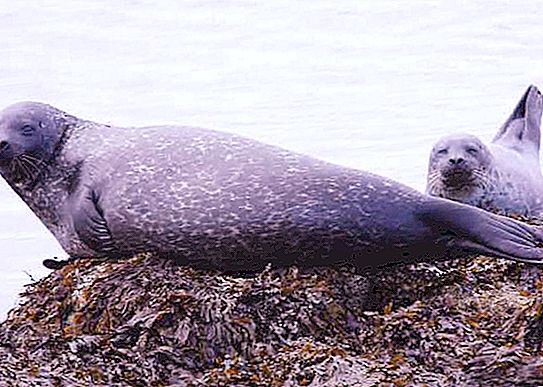
These include:
- monk seals (white-bellied, Hawaiian, Caribbean);
- elephant seals (northern and southern);
- Ross seal;
- Weddell seal;
- crabeater seal;
- sea leopard;
- lahtaka (sea hare);
- crested;
- common and spotted seals;
- seal (Baikal, Caspian and ringed);
- long face seal;
- harp seal;
- lionfish (striped seal).
All species of seals of this family are represented in the fauna of Russia.
Eared seals
The modern fauna numbers fourteen to fifteen species of eared seals. They are combined into two large groups (subfamilies).

The first group includes fur seals, including:
- Northern (the only species of the same name);
- Southern (South American, New Zealand, Galapagos, Kerguelen, Fernandez, Cape, Guadeloupe, Subantarctic).
The second group is formed by sea lions:
- Steller sea lion (northern);
- Californian
- Galapagos
- Japanese
- southern;
- Australian
- New Zealand.
In the waters of Russia, seals of this family are represented by sea lion and northern fur seal.
Protected species of seals
As a result of human active intervention in the life of nature, many animal species, including seals, are today on the verge of extinction.
So, several species of seals are listed in the Red Book of Russia at once. This is a sea lion that lives on the Kuril and Commander Islands and in the Kamchatka region. The spotted seal, or largha, living in the Far East, is also called rare. Currently protected is the gray long-mouted seal, or tevak. It is found in the Baltic Sea and on the Murmansk coast. On the verge of extermination was a ringed seal - a valuable Far Eastern fishing seal.
The Red Book of Ukraine contains a record of a monk seal. The conservation status of this species is designated as “missing”. This extremely shy animal has a low reproductive potential and does not withstand the close presence of a person. Only about ten pairs of monk seals live in the Black Sea, and in the world today their number totals no more than five hundred individuals.
Harbor seal
The common seal is distributed quite widely on the coasts of the northern seas of Europe. This species lives relatively settled, usually choosing rocky or sandy sections of the coastal zone, islands, shallows and streamers in bays and estuaries. The main food for him is fish, as well as aquatic invertebrates.
Cubs of these seals are usually born on the coast in May – July, and a few hours after birth they are sent to the water. They feed on mother's milk for about a month and manage to gain up to thirty kilograms on this nutritious diet. However, due to the fact that a large amount of heavy metals and pesticides get into the milk of the female seal because of the fish eaten by it, many cubs fall ill and die.
Despite the fact that this species is not listed as protected, for example, spotted seals or ringed seals, it also requires a careful attitude to itself, since its number is inexorably reduced.
Crabeater seal
The Antarctic crabeater seal is today considered the most numerous seal species in the world. According to various estimates, its number reaches from seven to forty million individuals - this is four times more than the number of all other seals.
The size of adult individuals is up to two and a half meters; they weigh two hundred and three hundred kilograms. Interestingly, females of this species of seals are somewhat larger than males. These animals inhabit the Southern Ocean, drifting near the coast in the summer, and migrating north with the onset of autumn.
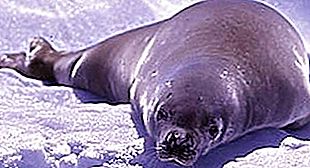
They feed mainly on krill (small Antarctic crustaceans), this is facilitated by the special structure of their jaws.
The main natural enemies of crabeater seals are the sea leopard and killer whale. The first poses a threat mainly to young and inexperienced animals. Seals escape from the killer whale, jumping with incredible dexterity onto the ice from the water.
